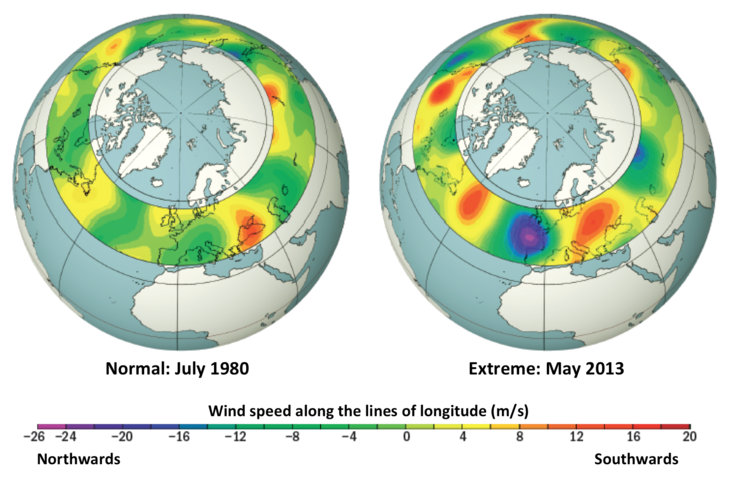Plenty more withering heatwaves, droughts, and flash floods are all on the forecast thanks to the effects of climate change. We already know rising surface temperatures across the globe are to blame for some of these extreme weather events. Just small increases in average temperature can lead to abnormally strong heatwaves and torrential rainfall.
But one team of researchers discovered that climate change is also causing changes to the movement of the jet stream – an atmospheric wave of air that circles the Earth. And this change to the flow of air can also take credit for causing extreme weather events across the globe. The findings add a new dimension to our understanding of how global climate change works and why extreme weather events last as long as they do.
The jet stream and climate change
For their study, researchers looked at historic atmospheric observations coupled with recorded events of floods, heatwaves, and wildfires. And they found a relatively recent slowdown in the global jet stream’s flow around the Earth could backwards predict large-scale climate patterns. Led by Pennsylvania State University’s Dr. Michael Mann, the findings are published in Scientific Reports.
“We came as close as one can to demonstrating a direct link between climate change and a large family of extreme recent weather events,” said Mann. “Short of actually identifying the events in the climate models.”

Researchers focused on events in the Northern hemisphere such as the 2003 European heat wave, the 2010 Pakistan flood and Russian heatwave, the 2011 Texas and Oklahoma heat wave and drought, and the 2015 California wildfires.
What they found was that the jet stream would at times become stationary and form peaks and troughs that lock in place. Most of these disturbances should dissipate over time. But under certain circumstances, the jet stream will confine itself on the north and south sides as if it were trapped inside a waveguide. And it’ll build up large peaks and valleys that remain in place as the air rounds the globe.
“If the same weather persists for weeks on end in one region, then sunny days can turn into a serious heat wave and drought, and lasting rains can lead to flooding,” said Stefan Rahmstorf, Potsdam Institute for Climate Impact Research (PIK), Germany.
Previous models looking at rising temperature alone tended to fall a little short. Rising temperatures can bring hotter days and even rainier ones since they add humidity to the air. But looking at the effects of a slowed jet stream explains why such weather patterns might persist for weeks on end.
The jet stream’s effects on the Arctic
The study also took a closer look at what’s happening in the Arctic, where temperatures are rising twice as fast as the rest of the planet. “The warming of the Arctic, the polar amplification of warming, plays a key role here,” said Mann.
Earth’s mid-latitudes usually have both the steepest temperature gradients and strongest jet streams on the planet. But sometimes those temperature gradients can decrease in a way that creates a weakened “double peak” jet stream with the strongest winds located to the north and south of the mid-latitudes. And this should trigger even more unusual weather patterns than before.
Future studies
Right now, Mann’s research was only able to look backwards at historical data, meaning it successfully reproduced weather patterns from the past. But the team does have plans to take a look at future projections and see what else climate change has in store for us.
“What’s up next is to examine the model projections of the future and see what they imply about what might be in store as far as further increases in extreme weather are concerned,” said Mann.
Climate change by the numbers
- 2016 was the hottest year on record and was the third year in a row to set that record since recordkeeping began in 1880.
- Up to a billion people in low-lying cities could be displaced by rising waters by the year 2060. South Asian cities like Mumbai and Kolkata, as well as the Southeast Asian peninsula will be some of the hardest hit. But the US will also see significant loss in places like Florida and the Gulf coast.
- One in six of the planet’s species are at risk of extinction barring any action to address global climate change.
- Global fisheries stand to lose $10 billion in annual revenue by 2050. Island nations that depend on marine diets the most stand to be the most impacted by shrinking supply.











